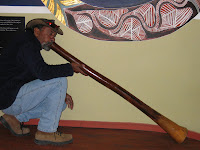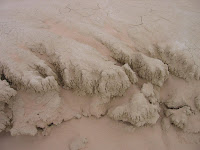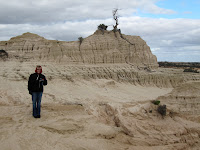We spent the night in Wentworth, a little hamlet past Mildura, as we had booked a package tour starting from there for Mungo National Park the next day. We booked the tour through an Aborigine company called the Harry Nanya tours. Our guide was none other than Graham Clarke, a famous Aborigine who is featured on TV in all the Qantas airline advertisements.

He drove a small bus and 10 of us to Mungo National Park.

To get there, we drove along a bumpy sand road (glad that we had not taken our own car as we had originally planned to do!) full of ruts and water.


Mungo National Park is at the centre of the Willandra Lakes World Heritage Area.


Here wind and rain have unearthed ancient fireplaces, cooking hearths,

burials and stone tools. Records of human ocupation date back well over 40,000 years. This year has been a wet year in Australia and after many years of drought, the road and dry lake bed of Lake Mungo have changed because of the moisture. As a result, trees, flowers and salt bushes have bloomed and blossomed again on the lake bed floor, which otherwise would have been just sand.


As we drove through the actual lake bed of Lake Mungo, we could see kangaroos and emus in the distance of the lake. Graham was able to call out to get the emus to come closer to us, as they are very curious creatures.


The tour was absolutely fabulous! Graham knows every bit of flora and fauna in the region.

He showed us trees where only the branches are poking out above the ground and the main trunk of the tree is buried underground to keep the moisture intact for the tree.

. These are great trees under which to sleep, providing a natural tent for the traveller, but the mallee gum trees are never reliable for sleeping under, as they can dismember themselves after a storm. The branches drink up the water and become so engorged, that they actually break off their own branches. They have been known to squash cars and even kill unwary tenters!

He shared every bit of history of the area and showed us relics in the sand,

and pointed out special formations from long ago.

He drew pictures in the sand for us about the geological formations


and about the current climatic conditions of the world,


told us about the Mungo 1 woman and the Mungo 2 man skeletons found in the area, probably dating back some 60,000 years. He made morning tea for us at one of the viewpoints


and then spread out a lunch for us in the courtyard of the sheep farming station,


played didgeradoo


for us in the Visitor's Centre



- just incredible! He is quite famous and has travelled throughout the world with archeologists, discussing the origin of mankind as well as the origins of the Aborigine people. He has his own distinct opinions about the Aborigine plight, and part of the tour was a series of lectures on issues facing the Aborigine peoples today,

what European farming has done to ravage the land, what the wine industry and irrigation has done to the rivers. The scenery we saw was just amazing - looking much like a desolate lunar landscape

with sand dunes

creating unusual formations everywhere.


Pictures simply cannot do justice to the grandeur of the "Walls of China",


as the formations created by erosion are called.

The "Walls of China"

were once shores to Lake Mungo, and they stand in breathtaking splendour as eroding pinnacles of sand and clay.


The different colours in the formations were phenomenal and although it was cool, the sun highlighted the formations in beautiful ways

and we were so glad that we had a chance to see them.

In the evening we wandered through the town of Wentworth,


known as the "Town on Two Rivers".

It is nestled at the forks of the Murray and Darling Rivers.

The Darling River is the longest river in Australia and is noticebly a different colour than the Murray River.

A hydroelectric dam operates at the junction.


The town boasts that it is the only town "saved by a tractor",

because when there was a flood in the past, the tractor was used to pull the logs and mud together to build a dike that saved the town from massive flooding! The beautiful setting sun provided such a glorious end to a wonderful day!

 He drove a small bus and 10 of us to Mungo National Park.
He drove a small bus and 10 of us to Mungo National Park.  To get there, we drove along a bumpy sand road (glad that we had not taken our own car as we had originally planned to do!) full of ruts and water.
To get there, we drove along a bumpy sand road (glad that we had not taken our own car as we had originally planned to do!) full of ruts and water. 
 Here wind and rain have unearthed ancient fireplaces, cooking hearths,
Here wind and rain have unearthed ancient fireplaces, cooking hearths,  burials and stone tools. Records of human ocupation date back well over 40,000 years. This year has been a wet year in Australia and after many years of drought, the road and dry lake bed of Lake Mungo have changed because of the moisture. As a result, trees, flowers and salt bushes have bloomed and blossomed again on the lake bed floor, which otherwise would have been just sand.
burials and stone tools. Records of human ocupation date back well over 40,000 years. This year has been a wet year in Australia and after many years of drought, the road and dry lake bed of Lake Mungo have changed because of the moisture. As a result, trees, flowers and salt bushes have bloomed and blossomed again on the lake bed floor, which otherwise would have been just sand. 
 As we drove through the actual lake bed of Lake Mungo, we could see kangaroos and emus in the distance of the lake. Graham was able to call out to get the emus to come closer to us, as they are very curious creatures.
As we drove through the actual lake bed of Lake Mungo, we could see kangaroos and emus in the distance of the lake. Graham was able to call out to get the emus to come closer to us, as they are very curious creatures. 
 The tour was absolutely fabulous! Graham knows every bit of flora and fauna in the region.
The tour was absolutely fabulous! Graham knows every bit of flora and fauna in the region.  He showed us trees where only the branches are poking out above the ground and the main trunk of the tree is buried underground to keep the moisture intact for the tree.
He showed us trees where only the branches are poking out above the ground and the main trunk of the tree is buried underground to keep the moisture intact for the tree.  . These are great trees under which to sleep, providing a natural tent for the traveller, but the mallee gum trees are never reliable for sleeping under, as they can dismember themselves after a storm. The branches drink up the water and become so engorged, that they actually break off their own branches. They have been known to squash cars and even kill unwary tenters!
. These are great trees under which to sleep, providing a natural tent for the traveller, but the mallee gum trees are never reliable for sleeping under, as they can dismember themselves after a storm. The branches drink up the water and become so engorged, that they actually break off their own branches. They have been known to squash cars and even kill unwary tenters!  He shared every bit of history of the area and showed us relics in the sand,
He shared every bit of history of the area and showed us relics in the sand,  and pointed out special formations from long ago.
and pointed out special formations from long ago.  He drew pictures in the sand for us about the geological formations
He drew pictures in the sand for us about the geological formations 
 told us about the Mungo 1 woman and the Mungo 2 man skeletons found in the area, probably dating back some 60,000 years. He made morning tea for us at one of the viewpoints
told us about the Mungo 1 woman and the Mungo 2 man skeletons found in the area, probably dating back some 60,000 years. He made morning tea for us at one of the viewpoints 

 - just incredible! He is quite famous and has travelled throughout the world with archeologists, discussing the origin of mankind as well as the origins of the Aborigine people. He has his own distinct opinions about the Aborigine plight, and part of the tour was a series of lectures on issues facing the Aborigine peoples today,
- just incredible! He is quite famous and has travelled throughout the world with archeologists, discussing the origin of mankind as well as the origins of the Aborigine people. He has his own distinct opinions about the Aborigine plight, and part of the tour was a series of lectures on issues facing the Aborigine peoples today,  what European farming has done to ravage the land, what the wine industry and irrigation has done to the rivers. The scenery we saw was just amazing - looking much like a desolate lunar landscape
what European farming has done to ravage the land, what the wine industry and irrigation has done to the rivers. The scenery we saw was just amazing - looking much like a desolate lunar landscape  with sand dunes
with sand dunes  creating unusual formations everywhere.
creating unusual formations everywhere. 
 as the formations created by erosion are called.
as the formations created by erosion are called.  The "Walls of China"
The "Walls of China"  were once shores to Lake Mungo, and they stand in breathtaking splendour as eroding pinnacles of sand and clay.
were once shores to Lake Mungo, and they stand in breathtaking splendour as eroding pinnacles of sand and clay. 
 The different colours in the formations were phenomenal and although it was cool, the sun highlighted the formations in beautiful ways
The different colours in the formations were phenomenal and although it was cool, the sun highlighted the formations in beautiful ways  and we were so glad that we had a chance to see them.
and we were so glad that we had a chance to see them. 
 known as the "Town on Two Rivers".
known as the "Town on Two Rivers".  It is nestled at the forks of the Murray and Darling Rivers.
It is nestled at the forks of the Murray and Darling Rivers.  The Darling River is the longest river in Australia and is noticebly a different colour than the Murray River.
The Darling River is the longest river in Australia and is noticebly a different colour than the Murray River.  A hydroelectric dam operates at the junction.
A hydroelectric dam operates at the junction. 
 The town boasts that it is the only town "saved by a tractor",
The town boasts that it is the only town "saved by a tractor",  because when there was a flood in the past, the tractor was used to pull the logs and mud together to build a dike that saved the town from massive flooding! The beautiful setting sun provided such a glorious end to a wonderful day!
because when there was a flood in the past, the tractor was used to pull the logs and mud together to build a dike that saved the town from massive flooding! The beautiful setting sun provided such a glorious end to a wonderful day! 























I'm not sure you will ever want to come home. Everywhere you go seems to be so clean and well-kept. My didgeridoo is sitting beside my piano waiting for someone to make an actual sound, so I am counting on you!!
ReplyDelete